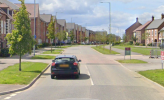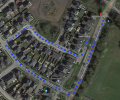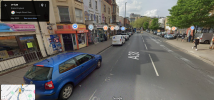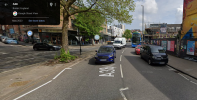TheManOnThe172
Member
- Joined
- 1 Aug 2014
- Messages
- 380
How about this as a method for getting a reasonable feel for the extent to which suburban car users might be expected to voluntarily take public transport instead:
For most of the suburban locations I have tried, at offpeak times, the 45-minute public transport range is vastly smaller than the 20-minute driving range - suggesting that there will be many destinations where even an enhanced-frequency bus service won't be competitive with car usage. And that is before allowing for the reduced convenience (heavy or bulky stuff to carry, children, mobility limitations - or multiple destinations in one trip) or comfort (sat in warm dry car vs standing at cold/damp bus stop).
I reckon it is going to take quite a lot of "stick" (eg road pricing and/or parking taxes) to get most suburban dwellers to shift a useful proportion of their existing car travel onto bus. But we seemed doomed to waste years demonstrating the limited modal shift impact of "carrots" (low/zero fares, better frequencies, mobility hubs) before politicians will come to accept the inevitable.
- Choose a drive-time value. Say 20 minutes as perhaps something close to the "modal" value of car trip.
- Calculate the travel time by public transport that might be a reasonable equivalent. To be generous to the "public transport" option I suggest adding 10 minutes to allow for time saved parking and walking from there to destination. Add a further 15 minutes to allow for the fact that bus itineraries today will be longer than those in an imagined future with heavier bus usage (because more users and/or heavier subsidies will justify better frequencies).
- Now choose a random suburban location (a home address, not a centre-of-locality location) and compare the area within your 20-min drive-time boundary and the area within the 45-min public transport travel-time boundary. The Traveltime app is good for this.
- Compare the size of the two areas to get a feel for how close to equivalence public transport might be in that imagined future.
- Repeat for other random suburban start points.
For most of the suburban locations I have tried, at offpeak times, the 45-minute public transport range is vastly smaller than the 20-minute driving range - suggesting that there will be many destinations where even an enhanced-frequency bus service won't be competitive with car usage. And that is before allowing for the reduced convenience (heavy or bulky stuff to carry, children, mobility limitations - or multiple destinations in one trip) or comfort (sat in warm dry car vs standing at cold/damp bus stop).
I reckon it is going to take quite a lot of "stick" (eg road pricing and/or parking taxes) to get most suburban dwellers to shift a useful proportion of their existing car travel onto bus. But we seemed doomed to waste years demonstrating the limited modal shift impact of "carrots" (low/zero fares, better frequencies, mobility hubs) before politicians will come to accept the inevitable.







